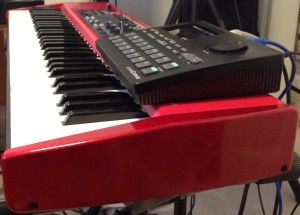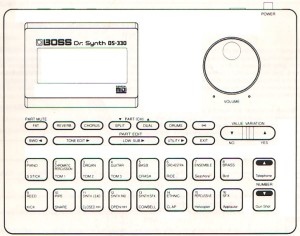Here’s some information attributed to Martin Harris from Yamaha. Martin is one of the key sound developers at Yamaha:
- Better Pianos
- New Strings – 70 piece Seattle Symphony Orchestra Mega
- New Orchestral Brass – highly dynamic
- New Tuned Percussion – Glock, Xylo, Marimba and Vibes (with motor on)
- New Mega guitars – Telecaster with Finger and Plectrum
- SA2 Celtic Violin
- New Synth Voices
- New Classical Choir – Cathedral ambience
- New Gospel Choir – Various articulations and Ad libs
- New Pop Vocals – 4 session singers, 2 male and 2 female
- Singing many dynamics and many articulations (wave cycling)
Montage? No, Tyros 4. The “SA2” should be a clue as the Montage does not provide Super Articulation 2 (SA2) voices.
My purpose here is not to be tricky, but to make the case that sample-based workstations or synthesizers draw from the sound pool that is available at development time, much the same way that hardware designers draw on the pool of available components. Products cannot be composed of imaginary circuits (“sand”), software, and sounds, after all.
To better illustrate this point, here is a rough timeline for the Tyros and Motif product lines with a few mid-range products (S9xx and MOX) thrown in:
Tyros Motif/Montage
---- ------------------ ------------------------------------------
Year Model Physical Model Physical Uncompressed waveforms
---- ------------------ ------------------------------------------
2001 Motif 48MB 84MB 1,309 waveforms
2002 Tyros 96MB
2003 Motif ES 96MB 175MB 1,859 waveforms
2004
2005 Tyros 2 192MB
2006
2007 Motif XS 128MB 355MB 2,670 waveforms
2008 Tyros 3 256MB
2009
2010 Tyros 4 512MB Motif XF 256MB 741MB 3,977 waveforms
2011 MOX 128MB 355MB 2,670 waveforms
2012 PSR-S950 256MB
2013 Tyros 5 768MB MOXF 256MB 741MB 3,977 waveforms
2014
2015 PSR-S970 2GB
2016 Montage 4GB 5.67GB 6,347 waveforms
I included physical wave memory size for each product. I also included the uncompressed total sample size and number of waveforms for each member of the Motif/Montage line.
Clearly, Yamaha know how to ride the memory technology curve. Memory technology has progressed to the point where it is no longer a significant hardware design factor. Rather, the amount of wave memory in a product depends more upon the ability of the sound designers to fill it with quality content and mid- versus premium-product grading (i.e., the target market segment and price point for the model). For example, note that the mid-range S970 has more than twice the physical wave memory than the Tyros 5. Although the “expansion memory” is reserved in the S970’s physical wave memory, the S970 waveform content is substantially smaller than the Tyros 5.
The other characteristic to note is how the Tyros and Motif lines tend to leapfrog each other. Generally, the Tyros line leads the Motif line in physical wave memory and content. This is partly due to the higher memory requirements of SA2 voices, which require many additional articulation samples.
Both the Tyros 4 and Motif XF were released in 2010. Both machines use two SWP51L tone generators. (Newer products like the Montage use the SWP70 tone generator.) The Tyros 4 has twice the physical wave memory capacity with respect to the Motif XF. Yet, the Tyros 4 has sample content which did not make it to a deliverable product in the Motif line until the Montage in 2016: Seattle strings, orchestral brass, Celtic violin, vocals (choir and scat), Telecaster guitar and suitcase electric piano.
Tyros 5 expanded this content in 2013. The Motif XF, on the other hand, received a significant update in January 2014. The V.150 update added the “Real Distortion” effects implemented by the Tyros 5. (A few Real Distortion effects actually premiered in the mid-range S950.) The V1.50 update and the “White Motif” color job were life-extenders for the Motif line. I’ve conjectured before that Montage development was late and this is further evidence.
So, what can we expect in the Tyros successor which I’m calling the “Tyros++”. (Yamaha have trademarked the name “GENOS” which may be the name of the follow-on. Only Yamaha really knows.) Personally, I’m hoping for the new orchestral woodwinds from Montage. These are superbly expressive voices. I’m also expecting improved electric pianos, again, of comparable quality to the Montage.
SA2 voices will probably remain exclusive to the Tyros line. Many folks hoped that Montage would have SA2 and it didn’t. SA2 is an important product differentiator — kind of like the premium “Natural” piano voices are to the Clavinova line. I suspect that FM voices will be a differentiator for the premium Montage line in years to come as well. Yamaha tends to think of these three product lines as distinct, so cross-over is carefully controlled and limited.
All of this talk about samples and wave memory size is overly reductionist. The three main (DMI) product lines — Tyros, Motif/Montage, Clavinova — have distinct personalities and features. Motif/Montage is a synthesizer for stage and production studio. Clavinova is primarily a home or church piano. Tyros serves double duty as a home keyboard and as a workstation for performing professionals. (Oddly, many USA customers scoff at this latter role.)
Although these are all fine instruments, the personalities have quirks. Upper-range Clavinovas are Tyros-in-disguise except for multi-pads, third RIGHT voice (i.e., only two voice layers in the right hand), and no expansion memory. Tyros does not have the deep editing or modulation features of the Motif/Montage. The Motif and Montage — strangely! — do not have a tonewheeel organ mode. This latter omission is hard to understand since the Montage competes against other “stage” products like the Korg Kronos and Nord Stage.
Having compared voice programming between PSR-S950 (Tyros 3 without SA2 voices) and MOX (Motif XS sound set), the product lines are voiced (programmed) differently. Motif/Montage effect programming has a harder edge than the Tyros, which is oriented toward oldies, pop and jazz standards. (Yes, Virginia, the Tyros does have latent EDM potential to be tapped.) If the Tyros++ includes the orchestral woodwinds, for example, they will probably be programmed rather differently than Montage. Tyros++ four-part divisi ensembles with the new orchestral woodwinds would be simply brilliant. Can’t wait to see and hear what happens!
One finally editorial comment. The world is filled with product reviews. Publications like Keyboard magazine, Electronic Musician, etc. focus on individual products and rarely present a deep, long-term perspective on products. Sound On Sound reviews occasionally give historical background — usually for esoteric, retro studio pieces. As consumers, we need the long view in order to make the most informed choice.


